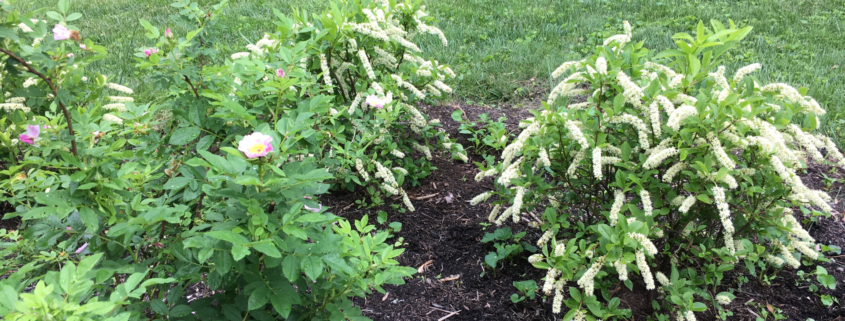Lawn Care for Earth Renewal
Article by Plant NOVA Natives staff
Let’s say you want to have a nice lawn, but you also want to be a good steward of the environment. Can you do both?
It turns out the answer is “yes.” Healthy yard practices can mitigate many of the problems caused by lawns. Because turf grasses are nonnative, lawns are ecologically useless and best minimized, but they have many uses such as human and pet playing surfaces and pathways for walking, and from an aesthetic perspective they make a nice contrast next to more complex plantings. It is possible to make small lawns neutral rather than actively harmful to the ecosystem.
The first thing to know is that turf grasses are native to Europe, which means they are poorly adapted to our local conditions. The conventional but destructive way to compensate for that is to add a lot of chemical inputs. The healthier alternative is to take a step back and realize that turf grass is a plant like any other, doing best when given good growing conditions. So we can start out by using turf grass only in areas where we can arrange those conditions without too much trouble and without harming the other beings that share our yards. Grass needs plenty of sunshine. To achieve good coverage in moderate shade requires reseeding it every year or two. You may be better off allowing shady areas to gradually reforest or creating a garden with shade tolerant native plants. Good coverage is more than just an aesthetic issue, since bare soil will erode and send sediment down to harm our waterways.
In sunnier areas, low-input lawn practices can yield excellent results, if not as regimented as a golf green. Here are the key steps to take.
- Test the soil, if your lawn or landscape is underperforming or if it has been three years since your most recent soil test. An inexpensive soil test will let you know the pH and any macro or micronutrient deficiencies that need correcting. Libraries and Master Gardeners booths have soil testing kits which you can submit to the Virginia Cooperative Extension, or you can use a private company.
- If the soil test indicates a deficiency, add organic matter. Like all plants, the roots of turf grass depend on the soil, including the fungal filaments that transport nutrients. The topsoil in many of our yards was stripped away during the construction process, leaving only the compacted clay subsoil. Adding compost (usually done in the spring, but any time is fine) restores the loose soil structure, nutrients and soil microbes that grass needs. A healthy soil (proper pH, nutrition, moisture and air levels, etc.) maintains a healthy and desirable microbial population. By contrast, adding chemical fertilizer kills the soil microbes and depletes the soil of its nutrients.
- Adjust the pH, if needed. If the pH is less than 6 or 7, nutrients will be less available to the cool season turf grasses. If the soil test results indicate a low or high pH, adjust as recommended.
- Maintain the height at 3.0 – 4.5 inches. Over 3.5 inches will look a little shaggier than we have come to expect but can help the plants thrive in challenging conditions and shade out undesirable weeds.
- Do core aeration once or twice a year to provide essential oxygen to the root zone.
- Overseed, if needed, after aerating in the fall. Shadier areas can be seeded spring and fall to maintain thicker turf cover.
- Water new seedlings regularly. If you can’t keep them watered, they may die.
- Avoid watering at other times. Overwatering makes the grass grow the juicy roots that grubs prefer.
- Leave the clippings on the ground to provide organic material.
- Leave the leaves when possible. A thin layer won’t hurt the grass, as some types of leaves will break down quickly and disappear over the winter. Thicker layers up to a point can be mulched and left in place to feed the soil. Try not to chop them up right away, though: give the butterfly pupa a chance to make their way to the ground. Wherever possible, leave the fallen leaves whole and in place to shelter the critters over the winter.
Of course, just because you can create a relatively harmless lawn, doesn’t mean a yard filled with lawn will support life. To give our birds, butterflies and bees the best chance of surviving, we will need to make native plants the default choice. But a judicious amount of lawn can be included in a strategy for creating habitats that are welcoming to all of us Earthlings. The Plant NOVA Natives website has details on how to manage lawn for a healthy ecosystem.




